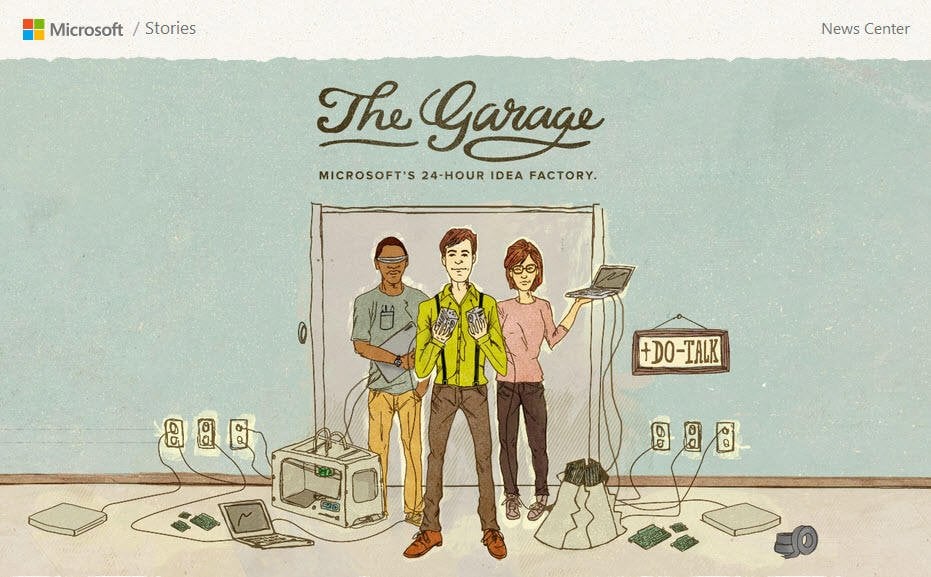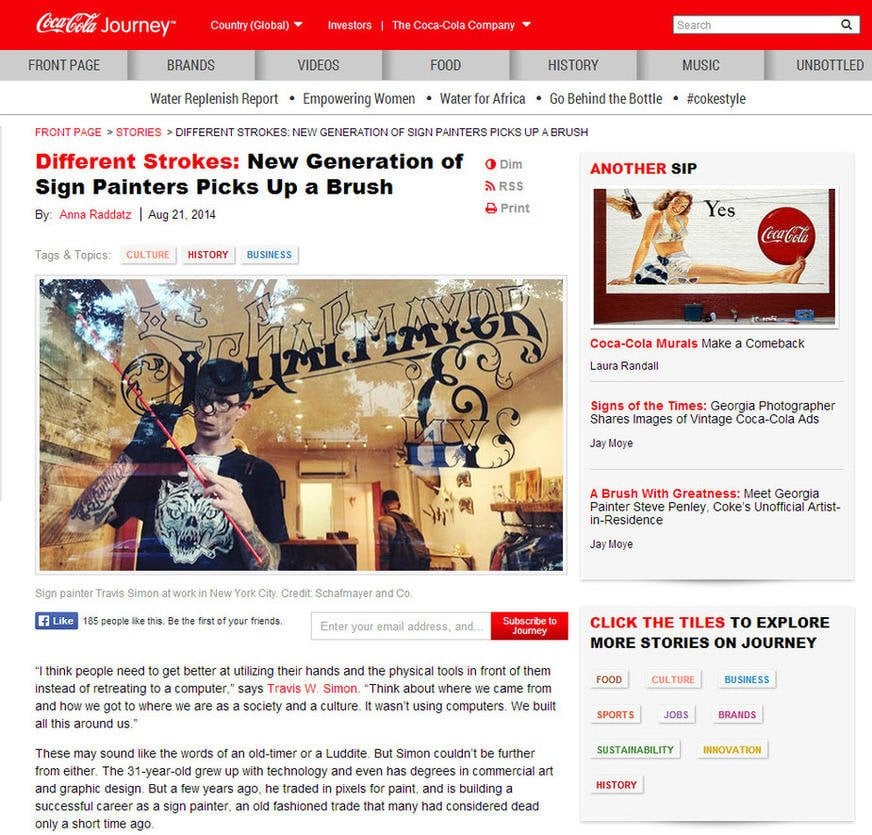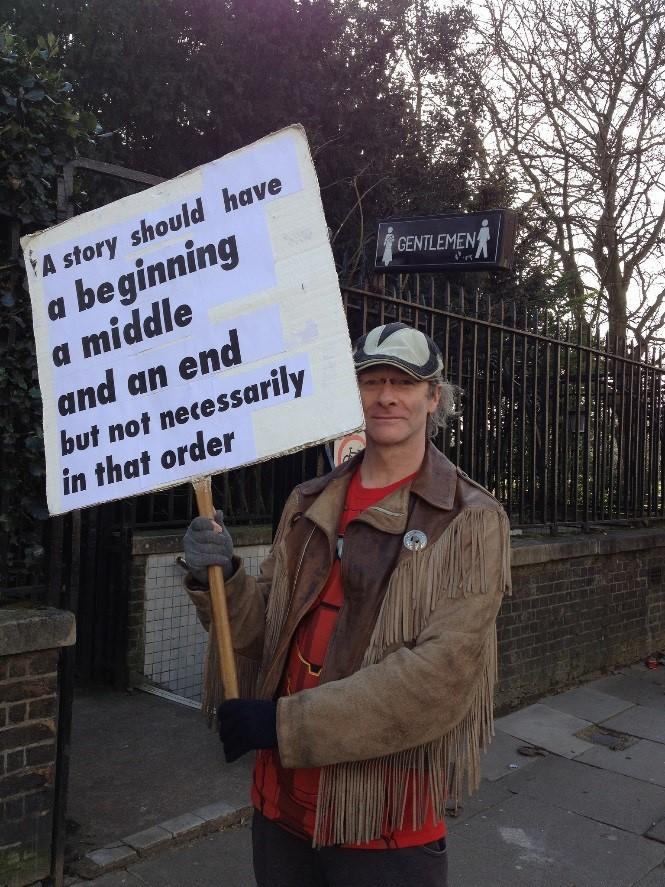I recently came across this video, in which renowned Austrian graphic designer Stefan Sagmeister tackles the stubbornly enduring marketing buzzword “storytelling.” In refreshingly candid and colorful language (some of which is NSFW, by the way), Sagmeister dismisses those who claim to be storytellers, because the majority of people who apply this label to their work simply aren’t storytellers.
Before we go any further, watch the video. It’s only two minutes long. Go ahead, I’ll wait.
WARNING: Again, this video contains some NSFW language. If you’re in the office, wear headphones.
Although Sagmeister is referring to the concept of the self-styled storyteller within the context of design, his remarks are equally applicable to content marketing. We keep hearing about the importance of storytelling in content marketing, how marketers “need” to become storytellers, and how audiences respond strongly to storytelling within a content marketing context.
In today’s post, I’m going to talk about why this, as Sagmeister so succinctly puts it, is bullshit.
Most Content Marketers are NOT Storytellers
Most people like to think of themselves as creative. Indeed, marketing as a discipline involves, if not requires, a great deal of creativity – and not just on the content side. However, even the most experienced bloggers and content marketers are not necessarily “storytellers.”
Bloggers and content producers with no demonstrable experience in storytelling who claim otherwise are misleading themselves and their clients or future employers. Just because I’ve filed tax returns in the past doesn’t make me a certified public accountant, and just because I drive a car doesn’t mean I can quit writing and join the professional stock car racing circuit.
You can’t see it from this angle, but there’s a huge WordStream logo on the other side.
Few content marketers possess either the skill or ability to truly tell stories with their content; it’s one of the biggest challenges in content marketing. This is not to say that to learn would be beyond them. In fact, many content marketers are ideally suited to learning the art of storytelling and how it applies to their job, but far fewer have experience of actually crafting engaging stories, especially in a business storytelling environment.
Despite this, “storytelling” has become one of the most insufferable content marketing buzzwords during the past couple of years, and it shows no sign of losing its luster any time soon.
Long-Form Content Isn’t Storytelling
Many content marketers confuse long-form content with storytelling, but a story is not defined by its word count.
You could write a 10,000 word blog post about paid search, but without a distinct beginning, middle and end, compelling characters and an overarching theme, it will just be a long blog post – NOT a story. True “stories” tend to be longer than the typical blog post, but they are most definitely not one and the same.
Why Content Teams Need Journalists
Interestingly, while many content marketing managers are actively seeking individuals with professional storytelling experience, far fewer are trying to hire actual journalists to fill these roles.
Hire a journalist and your content can have snappy headlines like this.
Alongside “storytelling,” the terms “brand journalism” and “embedded journalism” have become painfully trendy in marketing circles. Well-known brands such as Coca-Cola and Microsoft caught on early that, no matter how skilled a writer may be, without at least some journalistic skills, their work will lack the qualities necessary to be considered a story.
The Benefits of Hiring Journalists for Content Roles
If you’re expanding your content team or thinking of creating one, there are several reasons that a journalist could be a good fit.
For starters, the slow, agonizing death of the traditional newspaper industry has forced newsrooms across the country to radically downsize their teams. This has resulted in thousands of journalists seeking editorial roles outside of typical newspapers – including the marketing field. Compared to traditional reporting, many content marketing positions pay more, come with better benefits, and offer more job security, making them highly desirable to journalists who have become jaded by the rigors of the newsroom or the pressures of freelancing.
The newsroom of The New York Times, 1942
Another benefit of hiring journalists to fill content roles is their training. Journalists are taught to identify the “Five Ws” of information gathering, which form the basis of any news story:
- Who
- What
- When
- Where
- Why
Now, you could be forgiven for thinking that most news reports don’t read like stories – and you’d be right. Journalists usually focus on these five elements so that they can distill a potentially complex topic into a digestible news story that can be crammed into the precious column inches of a newspaper. However, once you can identify these five elements, you can take them far beyond the confines of a brief, impersonal news report and begin to craft a compelling narrative with a beginning, middle and end – in other words, a story.
Oh, and most journalists know how to meet deadlines, which makes them fast, reliable and dependable, all of which are valuable qualities for a content producer.
Not All Content Has to Tell a Story
Just as not all content marketers are storytellers, not all content tells a story. Fortunately, it doesn’t need to.
You only have to look at the success of clickbait sites such as BuzzFeed and Upworthy to see that most viral content tends to be shorter, list-based pieces (I’m sorry, but the word “listicle” still bothers me to the point that I avoid using it whenever possible), rather than long-form “stories.” Of course, BuzzFeed also publishes long-form narrative journalism, but it’s a relatively niche part of the site that doesn’t tend to attract nearly as many pageviews or social shares as the “fluff,” nor is it what the site is primarily known for.
Storytelling skills not required.
However, although most BuzzFeed content consists of “articles” like the example above, BuzzFeed does hire true investigative journalists. If you take a look at the job vacancy for this type of role at BuzzFeed, one of the requirements is to be able to, “Think constantly about how to tell the story during the reporting, actively seeking out details about character and narrative.” We’ll get to how to do this shortly.
Even longer, more detailed blog posts may not necessarily need to tell a story in order to work. Sometimes, a straightforward explanatory post about a given topic will suffice.
Brands That Genuinely ‘Get’ Storytelling
Some brands simply don’t have a clue about storytelling through content. Others, such as these examples, know how to not only grab their readers’ attention, but sustain it through traditional narrative techniques.
Microsoft
Think about brands such as Microsoft, and the chances are pretty good that compelling, engaging stories are not what immediately comes to mind. On the contrary, Microsoft is one of the few brands that really does genuinely “get” storytelling through content, as exemplified by the work of its Microsoft Stories team.
Jennifer Warnick’s “The Garage” focuses on the various engineers, hobbyists and technologists who frequent The Garage, Microsoft’s on-campus innovation lab.
Although The Garage itself is a character in Warnick’s story, the overarching themes in the piece are those of people coming together to solve common problems, the sense of camaraderie evident between the tinkers and makers who use the workspace to devise new products and services, and the spirit of experimentation more common among startups rather than old-school tech monoliths like Microsoft. The result was an engaging story about an interesting place, the people who spend time there, and how The Garage fits into Microsoft’s mission to modernize its business in the 21st century.
Coca-Cola
As much as it pains me to use such a ubiquitous corporate entity as an example of how to tell a story through marketing content, Coca-Cola really does know how to leverage narrative.
Coca-Cola’s online Journey magazine is filled with great examples of genuinely interesting, story-driven content, such as the example above, “Different Strokes” by Anna Raddatz. The piece details the personal stories of several traditional signage artists, practitioners of what some believe is a dying art, and how some artists are turning to the signs of yesteryear to inform their contemporary designs.
After examining the current state of sign artistry, the piece looks at the few remaining masters of the craft, how they are passing down their skills and wisdom to the next generation, and what the future holds for this unique profession.
How Marketers Can Tell Stories in Their Content
So, we’ve established that not all content marketers are storytellers, that not all content needs to tell a story, and seen some examples of how, done well, content can tell a genuinely interesting story. Now all we need to do is talk about how marketers can tell actual stories and avoid incurring the wrath of people like Stefan Sagmeister.
We’re going to use another Jennifer Warnick story for Microsoft, “88 Acres,” as an example. The piece focuses on how Microsoft combined enterprise-level data analytics technology with smart building innovations to radically improve the overall energy efficiency of its enormous Redmond, Washington campus.
Stories Have a Protagonist
Firstly, “88 Acres” isn’t about smart buildings – it’s about Darrell Smith, Microsoft’s director of facilities and energy. This makes Smith the protagonist of Warnick’s story. Although Warnick touches on several other individuals throughout the course of the piece, Smith drives the story forward, as he was the individual tasked with overseeing Microsoft’s energy efficiency project. Most of the story is told from Smith’s perspective and rarely strays far from his work, or – most importantly – his obstacles.
Stories Have Conflict
In fiction writing and storytelling, conflict is the basis of plot. To put it another way, without conflict, there is no story. Imagine Warnick’s story repurposed to remove the conflict:
- Darrell Smith is asked to make Microsoft’s campus more energy efficient
- He dutifully goes off and does it with no problems
- The end
Not exactly a gripping read.
In “88 Acres,” the conflict is Smith’s task to create and manage a building management system that will regulate outputs such as energy consumption, heating, air conditioning, water usage and dozens of other factors. This sounds simple enough in theory, but Smith’s main obstacle is the fact that most of the Microsoft campus’ five hundred buildings use different control systems. The obstacle, or conflict, in this piece is whether or not Smith will succeed in bringing all the disparate systems together.
Stories Have Structure
Cast your mind back to your elementary school English classes. Remember how your teacher patiently told you that stories must have a beginning, middle and end? Well, this still applies to your content if you’re going to tell yourself (or your clients, or your boss) that you’re a storyteller.
This man feels strongly about creative license.
If we look at “88 Acres” as an example, we see that the piece is structured like so:
- Beginning: Darrell Smith is introduced as the protagonist. Warnick provides us with some background on Smith and his role, and she reveals subtle details that reflect Smith’s character and attitude. Almost immediately, we gain a sense of the kind of man Smith is, and why he was entrusted with such an ambitious project.
- Middle: We are made aware of Smith’s main obstacle – the myriad different building management control systems he must tame to succeed, a large and technically complex task. We begin to understand just how ambitious Smith’s job is, which creates doubt about whether he will accomplish his goal (thus creating tension and compelling the reader to keep going). Warnick also introduces the story’s “supporting characters,” Tearle Whitson and Jonathan Grove, two engineers on Smith’s staff who will help him overcome his obstacles.
- End: Warnick shifts gears toward the end of the piece. She gradually reveals how, through hard work, determination and a great deal of ingenuity, Smith and his team overcome the technical obstacles and begin to realize they have not only transformed Microsoft’s campus into an energy-friendly facility, but also created a commercially viable product that can be licensed to other enterprise businesses.
Stories Have Pacing
It’s not enough to merely include the above elements in your work and call the finished result a story, because the most compelling narratives also make use of pacing to drive the action forward.
Sweet ride, bro.
One of the reasons that “88 Acres” is such an excellent example of content marketing storytelling is that Warnick spends just enough time expositing the necessary details, but she doesn’t just throw everything on the page. Pacing is vital for a story to succeed; spend too long building suspense or intrigue and your reader will lose interest. Move too quickly, on the other hand, and you risk losing or overwhelming your audience with the action. Read “88 Acres” and see how Warnick balances revealing the backgrounds of her characters, setting the scene and actually moving the story forward.
You Don’t Need a Campfire to Tell Stories
Content marketers with storytelling skills are indeed in high demand. However, knowing when – and how – to tell a story is just one aspect of this particular skill set.
As with any writing, telling stories through content takes time, practice and patience. Just be sure to know when to tell a story with content, and for the love of all things holy, don’t start going around calling yourself a storyteller if you’re not. Not everyone is a storyteller, and that’s okay.

















